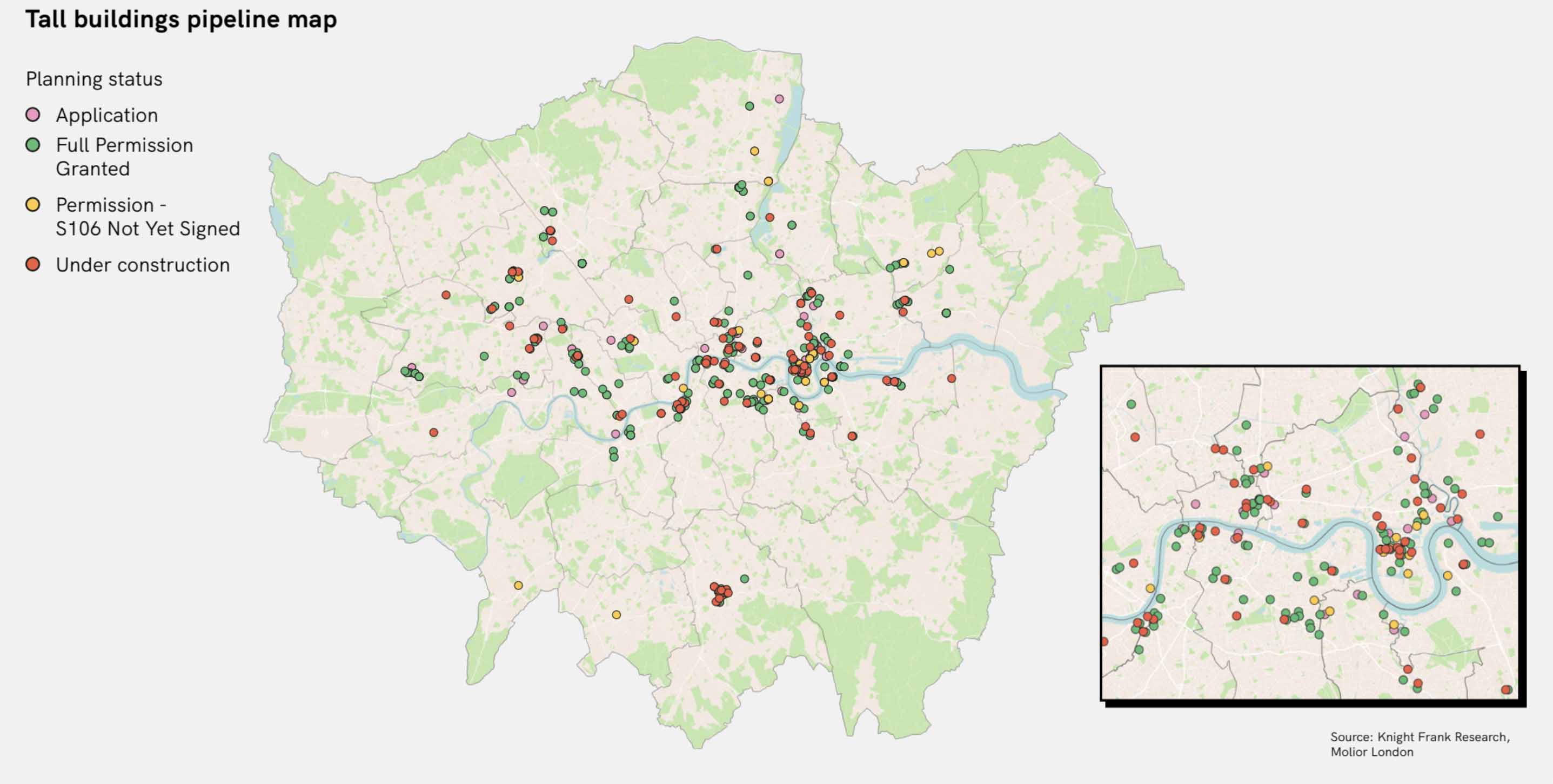Standing tall: What happened to London’s Tall Building pipeline in 2021?
The tall building pipeline may have contracted slightly in 2021, but the volume of 20-storey-plus towers planned for the capital remains significant.
4 minutes to read
There are signs of a slowdown of tall buildings in London, according to the results of the annual NLA Tall Building Survey, published in partnership with Knight Frank. The pipeline of 20 storey-plus buildings in the capital contracted 1% year-on-year in 2021, while the number of new planning applications put forward by developers and new construction starts – bellwethers for the state of the market – came in lower than long-term trends.
A slowing is not entirely unexpected; a combination of the uncertainties created by the pandemic, rising build costs, new safety measures, environmental regulations and increased affordable housing obligations have imposed greater scrutiny on high-rise development.
However, this year’s figures should not be interpreted as the end of tall building in London. Far from it. The survey points to a record level of planning permissions being granted last year, up 26% on 2020, and the number of completed projects was robust.
Context is also key. The future pipeline may have contracted slightly, but it remains significant. In total, there are 583 tall buildings which are proposed or approved with 109 currently under construction, figures which are 28% and 19% higher than back in 2016 respectively.
As we have noted in previous surveys, what is coming through the planning system and out of the ground, is increasingly across the outer London boroughs, in zones 3, 4 and 5, as well as for the Build to Rent sector, mirroring the trend in the wider new-build housing market. Commercial buildings account for 13% of the total pipeline.

Applications
Developers submitted 72 planning applications for tall buildings in 2021, down 13.3% on a year earlier and the third consecutive year applications have dropped. Submitted applications are 37% lower than the market peak in 2018. Of the 72 applications submitted in 2021, a total of 12 (17%) were granted full planning permission the same year and a further five were approved at Planning Committee but were yet to sign s106 agreements by 31st December. The average height of tall building applications put forward in 2021 was 28 storeys, though this varies by borough with an average of 31 storeys for applications across inner London boroughs to an average of 25 storeys in outer London.
Permissions
There were 98 full planning permissions granted in 2021, 36% higher than in 2020, and the highest annual figure on record. Some 56% of permissions were granted in outer London boroughs, including a combined 34 in Newham and Brent. In part, the high level of permissions granted reflects the bumper crop of applications submitted in 2018 and 2019 which continue to work their way through the system with 51% of consents last year for plans submitted in 2019 or earlier. However, it also suggests a willingness of Planning Committees to approve tall building proposals, either as standalone schemes or as part of a larger masterplan. Some 7% of permissions were for commercial buildings, down slightly from 13% the previous year.
Starts
In 2021, a total of 29 tall buildings commenced construction. While this was an increase on 2020, it represents the second lowest level of new starts for tall buildings across London since 2013. A drop in new starts is consistent with the decline seen in the wider London development market over the last couple of years. Rising build costs and ongoing supply chain disruption in recent years is likely to have impacted the viability of some projects, especially given the already higher costs associated with building tall. Given an average build time of just over three years for the tall buildings completed in 2021, we expect future surveys will register a slowing in delivery rate as the pipeline works its way through over the next three to four years.
Completions
In total, 34 residential and commercial tall buildings were completed in 2020, slightly below the 37 which completed last year and fewer than the 52 which were expected to complete according to last year’s survey. As in previous years, the data suggests that tall buildings are an increasingly deliverable form of development outside of the historically ‘prime’ areas, with 15 buildings completed in outer London in 2021, up from 10 in 2020. Notably, some 35% of the completions last year were for the BTR market, up from 24% the previous year.
The data suggests that 2022 could be a bumper one for completions, with 46 tall buildings expected to complete this year - a 35% increase on the 2021 total.
Methodology
Consistent with previous years’ London Tall Building Surveys, tall buildings have been defined as buildings of 20 storeys or above in height that are at various stages from application to construction. The data for 2021 refers to the period from 1st January 2021 until 31st December 2021. For residential schemes, current and historic data has been supplied by Molior London. ‘Completion’ refers to the point at which a building can be occupied. Where applicable, for larger sites, application, permission and start dates refer to individual buildings. Commercial building data comes from Knight Frank’s commercial building database. Please note that our data is dynamic and can be subject to revisions. Consequently, some figures may not be identical to those in previous editions.